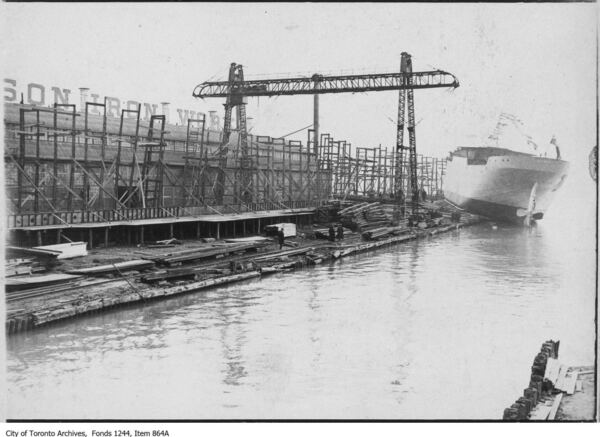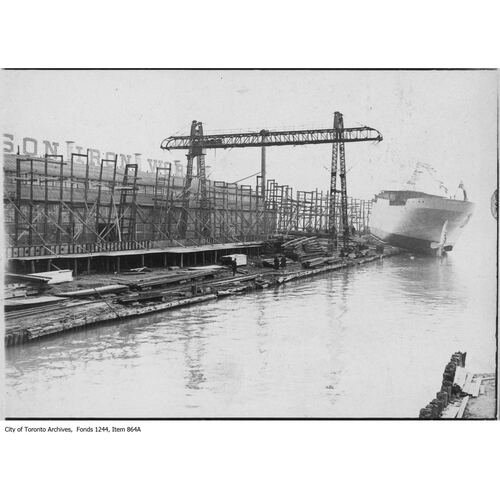As part of the funding agreement between the Dictionary of Canadian Biography and the Canadian Museum of History, we invite readers to take part in a short survey.

Source: Link
POLSON, FRANKLIN BATES, engineer and manufacturer; b. 10 Feb. 1858 in Port Hope, Upper Canada, son of William Polson (1834–1901) and Anna —; m. first 31 Dec. 1880 Emma A. Wood (d. 1886) in Cobourg, Ont., and they had a daughter; m. secondly 20 March 1901 Bessie Stephen Thompson, and they had a daughter and three sons; d. 28 Oct. 1907 in Toronto.
Educated at the Cobourg Collegiate Institute, Franklin B. Polson undertook the career practised by his father, a skilled machinist who was employed as mechanical superintendent for the Grand Junction Railway in Belleville. Franklin devoted almost ten years to learning the trade with the Cobourg, Peterborough and Marmora Railway and Mining Company, Hyslop and Ronalds (a firm of machinists in Chatham), and the Stearns Manufacturing Company of Erie, Pa. He became mechanical superintendent with the Victoria Railway in Lindsay, Ont., in 1881 and master mechanic of the Whitby division of the Midland Railway a year later. In 1883 both father and son resigned their positions to form William Polson and Company in Toronto. Located along the south side of the Esplanade, it was advertised as a firm of engineers, machinists, and machinery brokers with a specialty in building steam yachts. By 1885 it had expanded to include the production of boilers and hoisting, vertical, and marine engines.
The steady advancement of the business led to its incorporation on 23 Oct. 1886 as the Polson Iron Works Company of Toronto Limited, with William as president and Franklin as secretary-treasurer. Much capital was invested in making it the country’s best-equipped boiler and engine works. The most significant expansion of its trade occurred in 1888, when, in a successful bid to bring the firm’s shipbuilding operations to Lake Huron, the town of Owen Sound offered it a grant of land, an adjacent channel dredged at municipal expense, and exemption from property taxes for ten years. A by-law passed later in the year granted the firm $15,000 to acquire and expand an existing dry dock. The Canadian Pacific Railway had already selected Owen Sound as a terminus for its steamships. When it decided to replace the recently lost Algoma, the Polson works was well placed to tender for the contract, which it secured. The launch on 4 May 1889 of the Manitoba, the first Canadian-built, all-steel passenger vessel, seemed to confirm the Polsons’ conviction that the days of wooden shipbuilding in Canada were at an end.
Contracts for two more steel vessels followed. The Ontario, a car ferry built for the CPR’s run from Windsor to Detroit, used engines and boilers from the Polsons’ Toronto shop. The Seguin was a barge commissioned by the Parry Sound Lumber Company, whose president, John Bellamy Miller, had become a major shareholder in the Polson Iron Works in 1888 and a director two years later. F. B. Polson showed a reciprocal interest in the burgeoning lumber trade by assuming part-ownership of the Seguin and becoming vice-president of the Parry Sound Navigation Company Limited in 1890.
The affairs of his own company, however, kept Polson quite occupied. A mechanical and marine engineer who could also serve as a naval architect, he took a direct interest in the construction of each vessel. He secured orders for steam yachts in “steel, iron, composite or wood,” as well as contracts to build steel-and wooden-hulled fishery cruisers for the federal Department of Marine and Fisheries. This work kept the shipyard operating through 1891, by which time F. B. Polson had assumed the position of managing director, but the firm was soon caught up in the industry’s temporary decline. In spite of a massive recapitalization in 1888 and a voluntary liquidation in 1889, it was unable to honour its obligations regarding dredging and improvements to the dry dock at Owen Sound. In 1895 the town council refused to extend the period of tax exemption and two years later the Polson plant was moved back to Toronto.
In the midst of these difficulties, in 1893, the works had been reorganized, with Franklin Polson and J. B. Miller purchasing the assets of its corporate predecessor. Though Miller was registered as sole owner of the company in 1899, Polson maintained a dominant role in its affairs; by 1901 he had again become a partner. In 1905 the works would survive yet another reorganization.
The mainstays of the company during these lean years were engines and boilers, but by the end of the decade it had returned to shipbuilding, turning out at least two or three vessels each year. Polson and others lobbied the federal government almost annually for a bounty on Canadian-built tonnage, to counteract the cheaper iron, coal, labour, and capital available to British shipbuilders, but Prime Minister Sir Wilfrid Laurier* refused to act. In 1903, accompanied by John Joseph Long of the Collingwood Shipbuilding Company and other manufacturers, Polson visited Ottawa to request financial support instead for the construction of dry docks. Such subsidization would be legislated in 1910.
The Polson works had received sustenance from the minister of public works, Joseph-Israël Tarte, who commissioned two hydraulic dredges, to be manufactured as much as possible from parts made in the dominion. Although Tarte had misgivings about awarding the contracts “to the politically heretic city of Toronto” – its mps were Conservatives – he was impressed by Polson, who supported the Liberal party. Dredges of this type and scale had never been built in Canada, and Polson had to search the country for suitable suppliers. The launch of the J. Israel Tarte on 2 Sept. 1901 marked not only a turning-point for the Polson company, but also the beginning of a program of public building, primarily on the St Lawrence canals, that would provide steady work for the yard until World War I. Its production during the early years of the century of dredges, scows, ferries, and even the country’s first Canadian-built armed vessel, the Vigilant (constructed in 1903–4 to protect the Great Lakes fisheries), gave some credence to the claim of the Montreal Gazette that the federal government was “the most liberal patron of the ship-building yards on the Great Lakes.”
This spate of work led Polson to pursue an expansion of his plant. Negotiations were begun with municipal officials in 1906 to acquire an adjacent site, where a foundry could be set up to eliminate the firm’s dependence on American sources for steel, and to accommodate the construction of a passenger vessel. Polson’s sudden death on 28 Oct. 1907 at his Rosedale home left matters in abeyance. He had experienced severe indigestion since battling typhoid fever a few years earlier, but there had been few signs to prepare his family for this fatal turn of events.
Polson had led an active life away from business. He sat on the board of Grace Hospital in 1906, and advanced his interest in technical education by chairing the Toronto Technical School Board. Much of his leisure time was dedicated to the affairs of several clubs, particularly the Royal Canadian Yacht Club. A member of the Toronto Board of Trade since 1887, he served on the executive council of the Canadian Manufacturers’ Association in 1904–5. At his death he was a director of the Industrial Exhibition Association and a member of the Canadian Society of Civil Engineers. Polson also enjoyed respect among his peers as a founding member of the Employers’ Association, a body of manufacturers formed in Toronto in 1902 “to treat with organized Labour.” He subsequently played an important role in arbitrating several labour disputes.
F. B. Polson’s name is most closely associated with the many ships built under his care. Although his yards were kept employed chiefly by the construction of functional vessels, they also turned out a number of steam yachts whose fine lines commanded respect. Supported by a steady trade in boilers and engines for an expanding economy, Polson’s pioneering efforts in the Canadian steel shipbuilding industry were a significant contribution to the country’s maritime heritage.
AO, F 238, MU 3837, Polson to Roderick McLennan, 14 Aug. 1890; RG 8, I-1-D, 1888, file 3442; RG 22, ser.305, no.20648; RG 80-5, no.1880-207716. City of Toronto, Legal Dept. records, box 644, “Polson Iron Wk’s Co. re dredging Princess and Sherbourne Sts. slips”; box 1452, “Polson Iron Works vs. Toronto – suit H.J.C.” NA, MG 29, D61: 6627–54; MG 31, A10, 59, file 5; RG 31, C1, 1861, Port Hope, Ward 2: 4; 1871, Cobourg, div.3: 12 (mfm. at AO). St James’ Cemetery and Crematorium (Toronto), Tombstone inscription. Toronto Harbour Commission Arch., RG 1/4 (records of the board of commissioners), box 2, folder 9; RG 3/3 (central registry files), box 181, folders 8–9. Daily Mail and Empire, 8 Jan. 1901, 29 Oct. 1907. Evening Telegram (Toronto), 29 Oct. 1907. Globe, 1891–1907. Monetary Times, 1888–1901. Toronto Daily Star, 28–30 Oct. 1907. G. M. Adam, Toronto, old and new: a memorial volume . . . (Toronto, 1891; repr. 1972). Canadian annual rev. (Hopkins), 1901–3, 1905, 1907. M. M. Croft, Fourth entrance to Huronia: the history of Owen Sound (Owen Sound, Ont., 1980). Directory, Toronto, 1884–1907. An encyclopaedia of Canadian biography, containing brief sketches and steel engravings of Canada’s prominent men (3v., Montreal and Toronto, 1904–7), 2. Hist. of Toronto, vol.1. Industrial Canada (Toronto), 1 (1900–1)–5 (1904–5). Naylor, Hist. of Canadian business, vol.2. Toronto, Board of Trade, “Souvenir”. Toronto municipal year book, comp. Hubert Groves (Toronto), 1919: 30–32.
Cite This Article
Michael B. Moir, “POLSON, FRANKLIN BATES,” in Dictionary of Canadian Biography, vol. 13, University of Toronto/Université Laval, 2003–, accessed March 28, 2025, https://www.biographi.ca/en/bio/polson_franklin_bates_13E.html.
The citation above shows the format for footnotes and endnotes according to the Chicago manual of style (16th edition). Information to be used in other citation formats:
| Permalink: | https://www.biographi.ca/en/bio/polson_franklin_bates_13E.html |
| Author of Article: | Michael B. Moir |
| Title of Article: | POLSON, FRANKLIN BATES |
| Publication Name: | Dictionary of Canadian Biography, vol. 13 |
| Publisher: | University of Toronto/Université Laval |
| Year of revision: | 1994 |
| Access Date: | March 28, 2025 |



